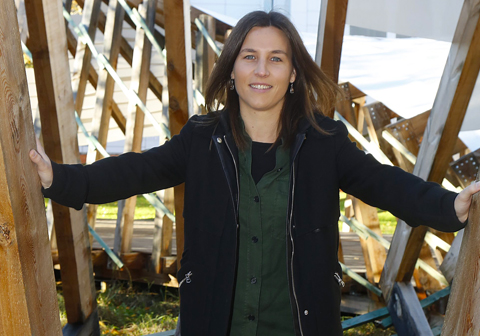Apart from being used as a Greenway, the Vasco-Navarro railway that used to cover about 150 km could go a step further and be used for relatively short trips on a daily basis that can be made on foot or by bike (commuting, getting to school, shopping, etc.), according to this study by the UPV/EHU-University of the Basque Country.
The potential of disused railway lines
A piece of research by the UPV/EHU-University of the Basque Country shows that many of the disused railway lines in the Basque Country have the potential for use beyond Greenways
First publication date: 25/11/2016

In the 19th and 20th centuries hundreds of kilometres of railway lines were built in the Basque Country and had great repercussions on the development of the surrounding villages. The railway organised and hierarchized the territory as well as, to some extent, modernising the villages through which it passed while sidelining the rest. Yet at the end of the 20th century, owing to the industrial decline and the competition posed by road transport, many kilometres of railway lines were closed down. Today, disused railway lines in the Basque Autonomous Community and Navarre cover more than 500 km. The research by the UPV/EHU's Department of Architecture set out to analyse all these old, disused railways lines and specify an analysis methodology to come up with appropriate solutions for reusing them in the future.
"There are many examples of successfully reusing disused railway lines, such as the High Line park in New York or the Greenway or "Vía Verde" schemes. However, they are all pieces of infrastructure mainly linked to leisure and tourism," explained Arritokieta Eizaguirre, a UPV/EHU researcher. "In this work she argues that the disused railway lines could go a step further by organising the territory around them as non-motorised hubs operating on an urban or interurban scale and be linked to everyday activities and habits (commuting, trips to school, shopping, etc.), apart from leisure and tourism purposes," stressed the researcher.
This research focussed on the study of the Vasco-Navarro railway, which used to be 150 km long and crossed the territories of Gipuzkoa, Araba-Alava and Navarre. To do this, the types of route that each railway line could have in each zone were specified. In other words, the potential of the said hub for fairly short daily trips, as well as for leisure and tourism purposes, was explored. Through an accessibility study, the relations existing between the disused railway line and the surrounding area were assessed. The study was carried out on three scales or different levels using a methodology adapted for each one in order to analyse the different zones that could exist around the line; a regional approach, referring to the towns/cities and villages linked by the disused railway line; an interurban approach relating to the areas close to the line; and an urban approach referring to the areas of urban or rural centres around the line.
A step beyond the Greenway ("Via Verde")
Today, much of the Vasco-Navarro railway is used as a Greenway The study conducted in this research concluded that the Vasco-Navarro railway has the potential for trips on foot or by bike apart from being used as a Greenway virtually the length of the whole line. "The border between Gipuzkoa and Araba-Alava (the Leintz-Gatzaga zone) is the only stretch that has no potential for this activity," said Eizaguirre. "There are zones that could be hubs for daily trips and others that could function thus in the future," she added.
On the other hand, the data on accessibility have enabled a geographical distribution of the different zones to be made: the towns of Gipuzkoa (Bergara-Eskoriatza), the zone under the influence of Vitoria-Gasteiz (Legutio-Erentxun), the small villages of Araba-Álava and Navarre (Gauna-Acedo) and the area under the influence of Lizarra-Estella (Antzin-Estella). "All these zones help us to understand the geographical distributions of the territory," pointed out the UPV/EHU researcher.
The analysis of the main towns shows that the zones close to Gipuzkoa have the highest levels of accessibility. Yet if one takes the urban centres into consideration, the results show that the village of Andollu is the most accessible. So "the future routes that could emerge initially would be directly related to the main cities and urban centres, while in the second case they would exert a greater influence on rural development," said the researcher.
Finally, the urban study facilitated the analysis of the relationship between the urban centre and its surroundings.
Therefore, through the methodology proposed, "this research has enabled us to specify the potential for non-motorised transport of the Vasco-Navarro railway," pointed out Arritokieta Eizaguirre.
This work is part of a piece of research exploring disused railway lines in the Basque Autonomous Community and Navarre. The research was funded by the Basque Autonomous Community Government through a Predoc grant.
Photo: UPV/EHU
Bibliographic reference
- A multilevel approach of non-motorised accessibility in disused railway systems: The case-study of the Vasco-Navarro railway.
- Journal of Transport Geography, 57, 35-43.
- DOI: 10.1016/j.jtrangeo.2016.09.009

